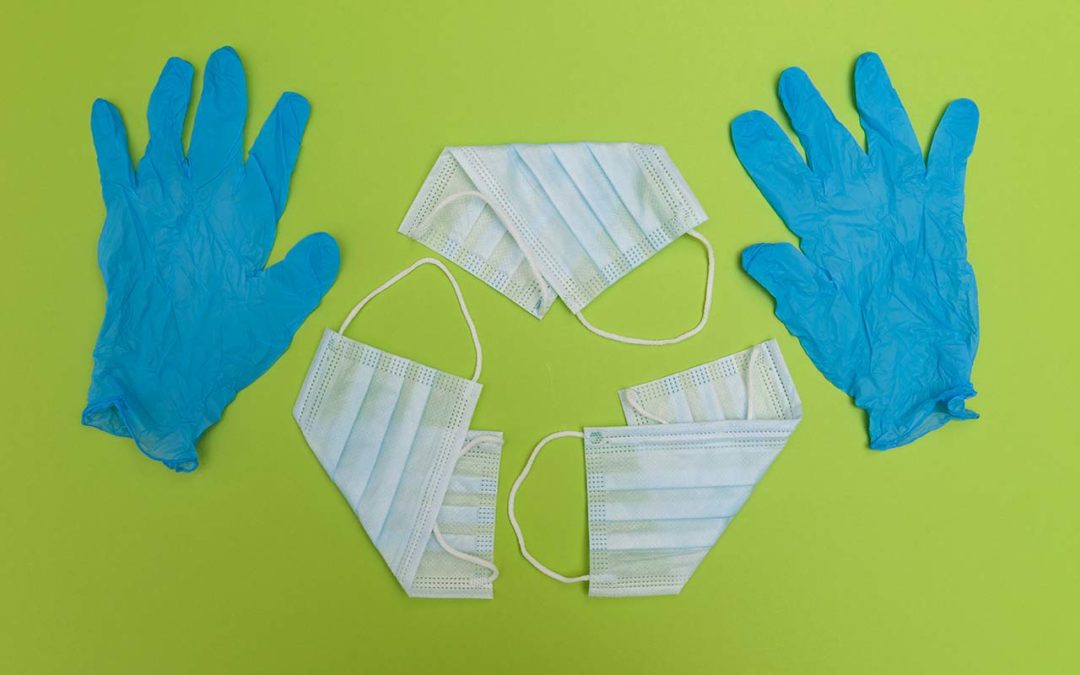Disposable personal protective equipment is littering our globe. Check out these options to help reduce the footprint PPE has on the world’s ecosystems.
Globally, we have not been able to get away from plastics since large-scale production began in the 1950s. This love story has yet to see a happy ending, although many advances and projects targeted to reduce, re-use and recycle plastic have been made worldwide. One of the major examples includes the law that has been passed by some countries to ban single-use plastics.
However, the COVID-19 pandemic has caused recycling initiatives worldwide to slow down and suffer. One of the culprits is the immense influx in global use of personal protective equipment (PPE) – disposable non-medical masks, surgical masks, respirators, surgical gowns, gloves – that were suddenly needed in massive quantities.
One of the biggest concerns we’ve seen worldwide since this influx of PPE has been confusion and carelessness about where and how to discard of these items.
Conventional recycling technologies do not apply to PPE, but there are still options available. The pandemic has ramped up plastic production (and pollution) worldwide, pointing out a huge need for education and development of programs to efficiently recycle PPE. These items are going to be a part of our lives for a while.
Plastics are here to stay
Researchers claim that plastic contamination in the world’s ecosystems is a near-permanent phenomenon. Most of the monomers (a tyle of molecule) that go into plastic production are created from a fossil hydrocarbon (coal, oil, natural gas). What’s more, none of the conventional plastics we use are biodegradable, so all they can do is accumulate in landfills and break up into smaller pieces – never fully disappearing or degrading. According to 2017 literature review, we have created 6.3 billion tonnes of plastic waste since 1950, and 91% of that has never been recycled.
PPE is also here to stay
Coupled with the pandemic, this is a major problem since we are steadily creating more un-recyclable waste due to the disposable nature and required use of PPE items. The materials in PPE are difficult to recycle at home and even in specialized facilities. This is because most PPE is created of non-biodegradable, petroleum-based ingredients. Often, recycling them costs more than what the resulting materials are worth.
PPE is a bio-hazard due to the risk of contamination, creating an even more complicated route towards re-using these materials. In Canada, most PPE is landfilled, while some is disinfected or incinerated. The Federal Government of Canada projects the demand for PPE in 2021 results to about 63,000 tons of COVID-19 related waste. There are legal guidelines for what PPE can be accepted to specialized recycling facilities and may vary per company. Knowing what could be re-used will help alleviate the immense waste that is forecasted for this year.
What can you do until PPE recycling is more standard?
An obvious trend during the COVID-19 pandemic has been the creation of more plastic waste. The Federal Government of Canada has said that this increased consumption is creating an urgent need to reduce PPE waste from landfills. Since conventional recycling sites are not all currently equipped to handle PPE, there are small other options available and small habits you can do until our regular facilities get upgraded.
Use machine-washable masks and biodegradable gloves. A more environmentally friendly option since these materials last longer. Although washing masks continually can be tiresome, doing this will alleviate stress on landfills and prevent more waste from affecting our ecosystem and wildlife.
Cut off mask straps. Remember those photos of turtles suffocating in plastic bags? Today, the newest addition to this plastic ocean cocktail are hospital gowns, latex gloves and masks. Remember to always cut off the straps to prevent wildlife from getting tangled in them. Also, put them in a proper garbage bin and never litter! In a short year, there are already signs that disposable masks are threatening wildlife worldwide, the biggest impact so far being seen in marine ecosystems.
Find a specialized recycling company that accepts PPE. Apart from committing to re-usable masks and biodegradable gloves, it is difficult to recycle PPE at home. Sending your PPE to a special manufacturing facility is an option. Be aware that despite your best efforts, PPE that is soiled (contaminated with blood or bodily fluids) cannot be accepted. It’s best to always check ahead and check with the facility, so that you don’t hinder their processing or compromise the health of its workers. If the PPE meets the facility’s requirements, you PPE may be re-used in ways such as:
- Face mask: converted to a raw material for use in plastic lumber and composite decking.
- Rubber band: ground up and added to other recycled plastics
- Latex gloves: ground into a power form and applied to creating tiles, playgrounds, or even athletic fields.
The war with plastic
We know that we’re using more plastic now – but how is the pandemic driving this trend? Behind the scenes, the pandemic has created a war that recyclers cannot keep up with. According to Reuters, recycling businesses have shrunk by 20% in Europe, 50% in Asia and up to 60% in the US since the coronavirus struck globally. The high demand for PPE, and the fact that its production requires new plastics has cut the cost of ‘virgin’ plastic material made by the oil industry. New plastic is more affordable and in high demand. Creating new plastic requires the use of fossil fuels. Now more than ever, we need to realize the importance of continued recycling and education on what the detrimental effects of plastic on our world.
If the pandemic does not shed light on the importance of recycling, and if people do not take small steps to reducing their waste, then the world will continue to drown in plastic. It is important to continue recycling and seek new options, such as PPE-recycling options.
